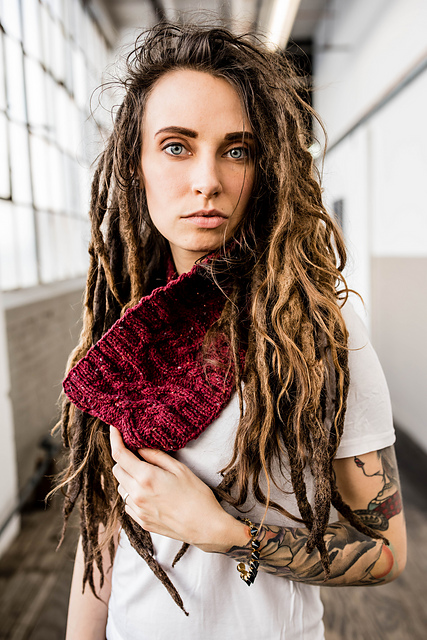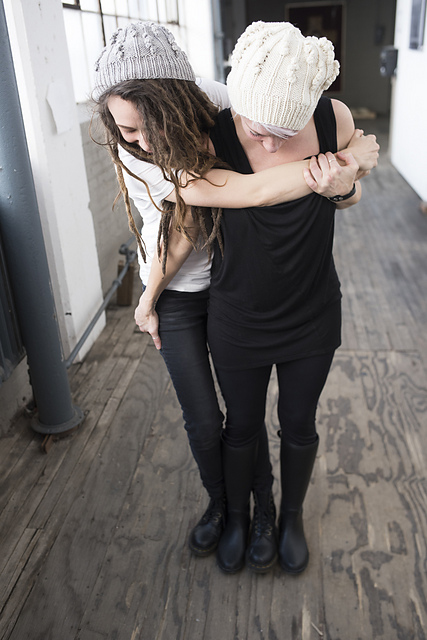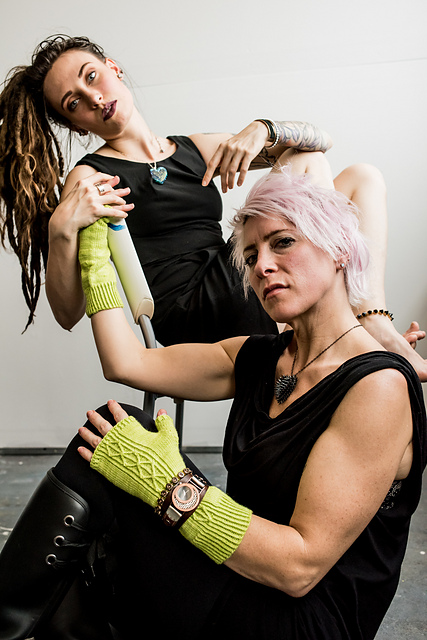My design output has dropped significantly in the past few years as I have been building Cooperative Press, my craft publishing business. I realized I needed to change that if I wanted to keep designing at all. My book The Knitgrrl Guide to Professional Knitwear Design is in line for a major overhaul this year, as is my website, but there were three other factors that drove me toward a new way of tackling everything at once.

Calantha shawl.
Photo by Amber Patrick /aterrormusical photography
In addition, I followed the recent #FairFiberWage discussion closely. Although teacher compensation and reimbursements kicked off that particular conversation, I know from being in this industry over a decade that teachers are not the only ones being expected to work for free or cheap. At a certain level, sample knitters make what designers do possible, and their compensation scale is all over the map.
Finally, I had a LOT of yarn staring me in the face that I neither had time to knit personally nor felt like moving, since we’re getting ready to move my studio for the first time since 2009. It was time for that yarn to go to work!
With all of these things in mind, I decided to create a Patreon project that could solve these multiple, more immediate problems, and hopefully even more problems for myself and other knitwear designers long term. Patreon is a website designed to allow creators to garner patronage in the form of monthly or per-item-release subscriptions from their fans. I chose to set my project up as per-pattern release, and to release the patterns once per week for a year. The base price is $4 per week, a discounted rate from current knit pattern pricing that is designed to take into account the fact there will be many different types of patterns being released. While I might only charge $5 for a simple hat pattern but $7 for a sweater on Ravelry, my patrons will get either pattern type for the same $4 each week. This also allowed me to make some basic projections: my initial goal is $1000 per release so I can afford to pay for all of the things that go into creating that pattern: technical editing, photography, models, my own time, my bookkeeper’s time running the numbers for the project—you name it.

Casta cowl.
Photo by Amber Patrick /aterrormusical photography
Kimber socks.
Photo by Amber Patrick /aterrormusical photography

Signy hat.
Photo by Amber Patrick /aterrormusical photography
As with most designers, I am always getting paid last, so I’m hoping we’ll go over the $1000 mark each week at Patreon. To be brutally honest, it’s tough to create when you’re constantly worried about your highly variable income, and anecdotal data from other designers confirms that everyone’s income is down overall. It’s why we’re seeing established designers with even longer track records than mine stepping back or stepping down altogether. It’s why I have been spending more time on the handmade craft shows I’ve been running since 2004 and less on knit design: I can rely on the income.
When I asked for interested sample knitters for the project, I got an overwhelmingly large response right off the bat. We formed a private Facebook group so we could communicate with them all at once. (By “we” I mean me and my longtime technical editor Andi Smith, without whom this project would not be happening at all.) I’ve been polling them about payment rates and other industry information on their particular portion of the front lines. And I’ve been scheming ways to improve their visibility, and (more importantly) their payment. Some things don’t even cost me anything! For example, I’ve been posting the sample knitter’s info on a credit line, the same as I do for my photographer, when the pattern is published.
The new way I’ve started looking at hand-knitting design is through a high fashion lens. No one thinks Karl Lagerfeld sews every piece that goes down the runway at Chanel. He’s responsible for sketching the looks, for handing them off to other skilled professionals for production, and for bringing them all together at the end in one cohesive, brand-focused THING (be it a runway show or a shop window). I’m good at that. I’m good at breaking the vision down into its component parts. I am NOT a fast knitter. I’m not a fast pattern writer either, honestly. (There’s a reason there are books and classes specifically on the art of writing knitwear patterns). What I am good at is rallying the necessary resources to create that collection and bring it to life with help from other pros.
In my case, the pros are the sample knitters, the tech editor, the photographer, the models, etc. I can’t (and shouldn’t!) do everything myself. It’s inefficient and it’s ineffective. And if I want to make a living wage in a challenging industry where my competition is willing to work for free or for cheap, I need to not only cut out as much inefficiency as I can, I need to put out a superior product.

Malus mitts.
Photo by Amber Patrick /aterrormusical photography
This Patreon probably looks like a real cash grab to some outside observers who don’t know what’s been going on in our industry. They’re probably rolling their eyes at the thought of $1000 per week “in my pocket” because no one really knows just how expensive it is to produce quality patterns. Yes, “in my pocket” is slightly sarcastic.
I can tell you off the top of my head that over a tenth of that $1000 is straight out the door just to keep my freelance bookkeeper working.
It’s akin to paying a full-time homemaker a living wage for the work she puts in. (Official estimates for that work range start at a low of $36,000, not counting overtime of more than $70,000, if you follow some of the calculations on this.) I have terrible allergies, so I pay a cleaner to come every two weeks. She makes about $25 an hour from me, which is well worth me not having allergy-induced migraines all the time. That’s a nice hourly sum, but I don’t know how much she’s putting aside to cover her self-employment tax, supplies, and all the other things she has to pay for out of that money.

Shannon Okey
contributor

Very interesting article! I’m currently setting up a crochet magazine as a side project and as soon as you start digging under the financial surface you realise that you won’t be giving up the day job for a long time, if ever!
I was excited to hear about this previously, and am glad that you’re sharing about it on here! Looking forward to hearing more about it as the year goes on.
What has me baffled is how you get past that catch-22 of paying professionals when you can barely feed yourself, but you need to do it to free up your time to start making money. That has always been my roadblock. How do you manage it?
Good for you, Shannon. I hope your Patreon project is a huge success. There are a LOT of us here in the creative world in need of a good monthly income. I teach online, but the quarterly schedule means my income is on a roller coaster – and does not match up well with monthly expenses. I’m looking at a similar continuity type program to generate a base income. I hope you’ll report back here at CIA to let us know how it’s going.
This is a really interesting idea! I have two groups of questions – one of which echos @marshalaw . Where does the money come from that pays the other professionals? How do you determine how much to pay them?
Also, how are you planning on providing the “nosiness factor” of advice? Via blog? Email that accompanies the patterns your subscribers get? Does this mean you are targeting professionals?
Great piece, Shannon.
While I have only designed a few patterns, I can certainly vouch for the costs involved. I, too, hire a tech editor, sample knitter, and going forward, I’m probably going to hire a photographer. I’ve only hired a photographer once, and I’m glad I did.
On the average, I need to receive a minimum of 40-50 pattern orders before I break even on paying professionals, and that does not take into account my time, advertising costs, supplies, etc.
That said, I wouldn’t do it any other way. There is a severe lack of professionalism in the pattern-writing world–not everyone, far from it, but, like many, I’ve gotten “hit” far too many times by purchasing a pattern only to find it poorly written. Designers owe it to their customers to do the right thing.
Is it possible to do the right thing and see a profit? Yes. Is it easy? No. And I’m just a knitter who sits in her kitchen and designs. I don’t have the overhead of a seasoned professional such as yourself. I cannot begin to imagine the costs.
As a proud backer, I wish you continued success with your Patreon efforts. You certainly deserve the support.